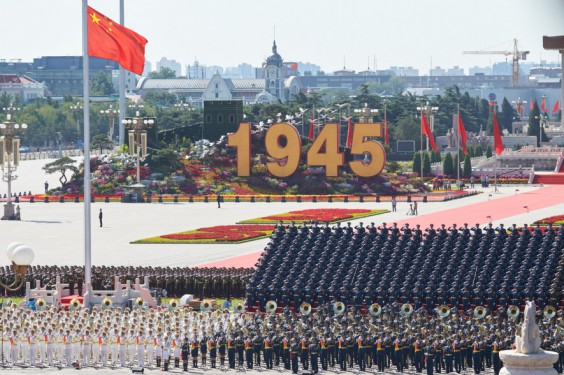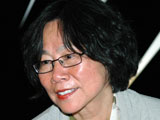A Late Summer Theater
by Tienchi Martin-Liao / September 18, 2015 / No comments

China's Victory Day Parade. Image via Wikimedia Commons.
Beijing’s parade commemorating the 70th anniversary of victory in the Second Sino-Japanese War is a failed attempt to suppress collective memory.
On September 3, the Beijing government held an ostentatious and supercilious military parade to celebrate the 70th anniversary of Japan’s unconditional surrender at the end of the Second Sino-Japanese War. Under the smile of President Xi Jinping, and in full view of dignitaries and 30 visiting heads of state, glittering high-tech weapons, ballistic missiles, helicopters, drones, tanks, and heroic solders in hara-kiri-spirits marched through Tiananmen Square, though an audience waving colorful flags. Meanwhile, the five largest hospitals in the capital city were closed on the day of the parade. Shops, restaurants and service centers in the five main downtown business districts were also forced to close for one to three days.

- During the Cultural Revolution, people were sentenced to death or outright murdered because of one wrong sentence. In China today writers do not lose their lives over their poems or articles; however, they are jailed for years. My friend Liu Xiaobo for example will stay in prison til 2020; even winning the Nobel Peace Prize could not help him. In prison those lucky enough not to be sentenced to hard labor play “blind chess” to kill time AND TO TRAIN THE BRAIN NOT TO RUST. Freedom of expression is still a luxury in China. The firewall is everywhere, yet words can fly above it and so can our thoughts. My column, like the blind chess played by prisoners, is an exercise to keep our brains from rusting and the situation in China from indifference.

- Tienchi Martin-Liao is the president of the Independent Chinese PEN Center. Previously she worked at the Institute for Asian Affairs in Hamburg, Germany, and lectured at the Ruhr-University Bochum from 1985 to 1991. She became head of the Richard-Wilhelm Research Center for Translation in 1991 until she took a job in 2001 as director of the Laogai Research Foundation (LRF) to work on human rights issues. She was at LRF until 2009. Martin-Liao has served as deputy director of the affiliated China Information Center and was responsible for updating the Laogai Handbook and working on the Black Series, autobiographies of Chinese political prisoners, and other human rights books. She was elected president of the Independent Chinese PEN Center in October 2009 and has daily contact with online journalists in China.
Additionally, in five neighboring provinces, including Beijing and Tianjin, factories were ordered to stop production from August 28 to September 4 so pollution would not dim the blue sky. “Guarantee blue sky for the parade” is an industry and public motto in China. Even 144 kilometers away from Tiananmen, in the small town of Anxin, Hebei province, the local officer forbid the people from even cooking because the smoke could disturb the mood of majesty.
In a country like China, miracles can be ordered. Common people and nature alike bow to the power of the state. In the name of “history,” the rulers in Beijing want to demonstrate their military power, to intimidate the old enemy Japan and its supporters—namely the United States. The showy, ostentatious parade serves as a memory suppressant. By viewing this superlative muscle show, the Xi administration wants the people to forget the recent Tianjin chemical explosion; forget the dropping RMB and the stock market crash; forget that 26 years ago, on that same spot, the Chinese Liberation Army rolled in tanks and slaughtered civilians; forget that Mao and his Communist Party killed more people in peacetime than the Japanese in wartime; forget that the United States was China’s ally in the fight against the Japanese invaders more than 70 years ago.
Manipulating history and obliterating collective memory has long been practiced in China, but now there a grassroots movement is working against it. Zhang Dongpan is a self-taught historian. He grew up in Beijing and knows that China’s history in the 20th century is embedded in a minefield; it is neither taught in school nor discussed in private. No books or information can be found in libraries, and it is a taboo subject in the media. In 1999, Zhang incidentally discovered some old photos that showed the unknown story of the Second Sino-Japanese War. The Americans stood in a totally different light; they were not “imperialists,” as the government’s mouthpiece claimed, but friends and comrades of the Chinese. Zhang traced these photos back to the original source, the US National Archives in Washington, D.C. What he found was stunning: 23,000 pictures taken by the photography squad of the US Army Signal Corps, captured between 1943 and 1945. They showed the hardship of war — but without hatred — and the cooperation, compassion, sympathy and friendship between the US soldiers and the common Chinese people. On the back of each photo, there was a very detailed description of each image.
These precious artifacts were brought back to the US and housed in the National Archives in 1946. With few exceptions, most of them had not been touched until Mr. Zhang and his team from Beijing arrived in 2010. They worked for two months to scan or re-photograph the pictures, because some of them were damaged due to age and needed repair. This vivid evidence brings an annihilated history into light: American soldiers fought with the Nationalist Army against the Japanese in the China-Burma-India Theater under General Joseph Stilwell. This area was the only artery to the Chinese mainland that had not been cut off by the Japanese, and it was through this highway all the military equipment, energy, and logistic materials from the outside world were brought into China.
Zhang was struck by these pictures, as they told him two facts that conflicted with his official historical knowledge: that the Chinese Communist Party and its Red Army defeated the Japanese alone, and that while the US fought in the European battlefield, it played a minor role in the Second Sino-Japanese War. After studying the photos, he discovered that there were over 25,000 American soldiers and volunteer civilians fighting shoulder-to-shoulder with Chinese in the war, not to mention the legendary General Claire L. Chennault with his “Flying Tigers.” He also learned that Chiang Kai-shek and his Nationalist army fought the main battles in the war. Over 1.31 million Nationalist soldiers died, and including missing and wounded, the Nationalists suffered almost four million casualties—more than five times the casualties of the Communist’s Red Army. Zhang and his team digitized all the photos and texts, and in 2012 he published them in two volumes, entitled National Memory (Guojia Jiyi). They held several photo exhibitions in Shenzhen, Tengcong, Chongqing, Taipei and Washington D.C.
General Martin Dempsey, Chairman of the Joint Chiefs of Staff, opened the latest exhibition in D.C. Retired Army Colonel John Easterbrook, the grandson of General Stilwell, also attended the ceremony. Both Zhang and Colonel Easterbrook said that in the past, for well-known reasons, the true history was buried in China and almost forgotten in the US. Through the exhibition of these old pictures, millions of Chinese are facing the historical truth; their memory is awakened.
Now let’s return to the September 3rd military parade, which, in the words of the scholar and analyst Sergey Radchenko, “aimed to ‘remember history and cherish the memory of martyrs.’ Shedding Mao’s earlier and simpler message of triumph, President Xi Jinping seeks to wed the 1949 Communist victory in 1949 to the notion of Chinese victory in the war against Japan in 1945, and project this victory as part of the global anti-fascist struggle. This interpretation simply has no basis in fact. It mystifies, glorifies, and simplifies China’s arduous struggle — a struggle that was as much with itself as with Japan, that was lost as much as it was won, and that left very little glory in its wake, only boundless misery to feed the cauldron of the Chinese revolution.”




